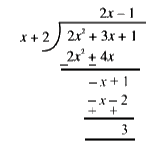IF one of the vertices of a square is (3,2) and one of the diagonalls is along the line 3x+4y+8=0, then find the centre of the square and other vertices.

We have square ABCD, where coordinates of A are (3,2).
Clearly, point (3,2) does not satisfy the line 3x+4y+8=0.
Thus, diagonal BD is along this line.
M(h,k) is centre of the square, which is the foot of perpendicular from vertex A on the diagonal BD.
∴h−33=k−24=−(3(3)+4(2)+8)32+42
⇒h−33=k−24=−1
⇒(h,k)≡(0,−2),
which is the centre of the square.
M is midpoint of AC.
∴C≡(−3,−6)
Now,AM=|3(3)+4(2)+8|√32+42=1
∴MB=MD=1
Slope of BD =−34=tanθ, whereθ is inclination of BD with x-axis.
Therefore , coordinates of B and D are
(0±1⋅cosθ,−2±1⋅sinθ)
≡(0±1(−45),−2±1(35))
≡(−+45,−2±35)
≡(−45,−75),(45,−135)
Topper's Solved these Questions
- STRAIGHT LINESBOOK - CENGAGECHAPTER - STRAIGHT LINESEXERCISE - Exercise 2.1
23 Videos
- STRAIGHT LINESBOOK - CENGAGECHAPTER - STRAIGHT LINESEXERCISE - Exercise 2.2
4 Videos
- STRAIGHT LINEBOOK - CENGAGECHAPTER - STRAIGHT LINEEXERCISE - Multiple Correct Answers Type
8 Videos
- THEORY OF EQUATIONSBOOK - CENGAGECHAPTER - THEORY OF EQUATIONSEXERCISE - JEE Advanced Previous Year
9 Videos
Similar Questions
Knowledge Check
If a vertex of a square is at the point (1,−1) and one of its sides lie along the line 3x−4y−17=0, then the area of the square is
A4 sq. unitsB3 sq. unitsC12 sq. unitsD2 sq. units
Each side of a square is of length 6 units and the centre of the square Is ( - 1, 2). One of its diagonals is parallel to x+y=0. Find the co-ordinates of the vertices of the square.
View SolutionEach side of a square is of length 6 units and the centre of the square Is ( - 1, 2). One of its diagonals is parallel to x+y=0. Find the co-ordinates of the vertices of the square.
View SolutionIf one of the sides of a square is 3x−4y−12=0 and the center is (0,0) , then find the equations of the diagonals of the square.
View SolutionIf one of the sides of a square is 3x-4y-12 = 0 and the center is (0,0), then find the equations of the diagonals of the square.
View SolutionIf one of the sides of a square is 3x−4y−12=0 and the center is (0,0) , then find the equations of the diagonals of the square.
View SolutionIf one sides of a Square is 3x−4y−12=0 and the center is (0;0) ; then find the equation of the diagonals of the square.
View SolutionThe center of a square is at the origin and its one vertex is A(2,1). Find the coordinates of the other vertices of the square.
View Solution
